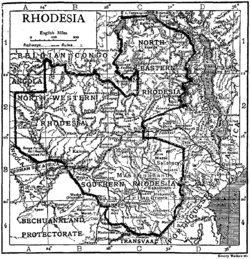
Back حكم الشركة في رودسيا Arabic Administration de la Rhodésie par la British South Africa Company French רודזיה תחת שלטון חברת דרום אפריקה הבריטית HE Rhodesië Dutch Kutonga kweKambani muRhodhezhiya Shona Britanya Rodezyası Turkish
Rhodesia | |||||||||||
|---|---|---|---|---|---|---|---|---|---|---|---|
| 1888–1924 | |||||||||||
| Motto: "Justice, Commerce, Freedom" | |||||||||||
 Rhodesia under Company rule in the 1911 Encyclopædia Britannica | |||||||||||
| Status | Chartered territory of the British South Africa Company | ||||||||||
| Capital | Salisbury | ||||||||||
| Common languages | English (official) Shona, Northern Ndebele, Bemba and Chewa widely spoken | ||||||||||
| Historical era | New Imperialism | ||||||||||
• Chartered | 1888 | ||||||||||
• Pioneer Column; start of Company rule | 1890 | ||||||||||
• Named "Rhodesia" | 1895 | ||||||||||
| 1923 | |||||||||||
• Direct British rule for Northern Rhodesia | 1924 | ||||||||||
| Currency | Pound sterling | ||||||||||
| |||||||||||
| Today part of | |||||||||||
| |||||||||||
The British South Africa Company's administration of what became Rhodesia was chartered in 1889 by Queen Victoria of the United Kingdom, and began with the Pioneer Column's march north-east to Mashonaland in 1890. Empowered by its charter to acquire, govern and develop the area north of the Transvaal in southern Africa, the Company, headed by Cecil Rhodes, raised its own armed forces and carved out a huge bloc of territory through treaties, concessions and occasional military action, most prominently overcoming the Matabele army in the First and Second Matabele Wars of the 1890s.[n 1] By the turn of the century, Rhodes's Company held a vast, land-locked country, bisected by the Zambezi river. It officially named this land Rhodesia in 1895, and ran it until the early 1920s.
The area south of the Zambezi became Southern Rhodesia, while that to the north became North-Western and North-Eastern Rhodesia, which were joined in 1911 to form Northern Rhodesia. Within Northern Rhodesia, there was a separate Kingdom called Barotseland which later became a British protectorate alongside other territories under the British sphere of influence. Each territory was administered separately, with an administrator heading each territorial legislature. In Southern Rhodesia, which attracted the most white immigrants and developed fastest, a legislative council was established in 1898. This comprised a blend of Company-nominated officials and elected members, with the numbers of each fluctuating over time.
Partially motivated by Rhodes's dream of a Cape to Cairo Railway, railway and telegraph lines were laid across previously barren Rhodesia with great speed, linking South Africa to the Belgian Congo's southern Katanga province by 1910. The British South Africa Police, responsible for law enforcement in Southern Rhodesia, was established in 1896. A number of police forces north of the river amalgamated to form the Northern Rhodesia Police in 1911. Northern and Southern Rhodesians fought alongside the British in the Second Boer War and the First World War; about 40% of Southern Rhodesian white men fought in the latter, mostly on the Western Front in Europe. Black soldiers served in East Africa with the Rhodesia Native Regiment.
As the number of elected members in the Legislative Council rose, power in Southern Rhodesia gradually transferred from complete Company rule to effective self-government by the growing number of white settlers. In a 1922 referendum, Southern Rhodesians chose responsible government within the British Empire over incorporation into the Union of South Africa. The Company's charter was duly revoked by Whitehall in 1923, and Southern Rhodesia became a self-governing colony of Britain in October that year. Northern Rhodesia became a directly-run British protectorate in April 1924.
- ^ Groenewald 2007, p. 52; Marston 2010, p. v; Stapleton 2011, p. 41
Cite error: There are <ref group=n> tags on this page, but the references will not show without a {{reflist|group=n}} template (see the help page).

